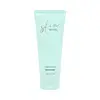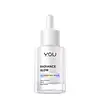What's inside
What's inside
 Key Ingredients
Key Ingredients

 Benefits
Benefits

 Concerns
Concerns

 Ingredients Side-by-side
Ingredients Side-by-side

Water
Skin ConditioningGlycerin
HumectantDimethicone
EmollientOctyldodecanol
EmollientPhenoxyethanol
PreservativePolyacrylamide
Acrylates/C10-30 Alkyl Acrylate Crosspolymer
Emulsion StabilisingC13-14 Isoparaffin
EmollientSilica
AbrasiveCetearyl Olivate
Sorbitan Olivate
EmulsifyingSodium Hydroxide
BufferingPotassium Hydroxide
BufferingDimethicone/Vinyl Dimethicone Crosspolymer
Skin ConditioningLaureth-7
EmulsifyingSalicylic Acid
MaskingEthylhexylglycerin
Skin ConditioningParfum
MaskingDisodium EDTA
Glycyrrhiza Uralensis Root Extract
Skin ConditioningSchisandra Chinensis Fruit Extract
Skin ConditioningPaeonia Lactiflora Root Extract
Skin Conditioning1,2-Hexanediol
Skin ConditioningHippophae Rhamnoides Fruit Extract
Skin ConditioningSalix Alba Bark Extract
AstringentWater, Glycerin, Dimethicone, Octyldodecanol, Phenoxyethanol, Polyacrylamide, Acrylates/C10-30 Alkyl Acrylate Crosspolymer, C13-14 Isoparaffin, Silica, Cetearyl Olivate, Sorbitan Olivate, Sodium Hydroxide, Potassium Hydroxide, Dimethicone/Vinyl Dimethicone Crosspolymer, Laureth-7, Salicylic Acid, Ethylhexylglycerin, Parfum, Disodium EDTA, Glycyrrhiza Uralensis Root Extract, Schisandra Chinensis Fruit Extract, Paeonia Lactiflora Root Extract, 1,2-Hexanediol, Hippophae Rhamnoides Fruit Extract, Salix Alba Bark Extract
Water
Skin ConditioningPropanediol
SolventPPG-24-Glycereth-24
EmulsifyingButylene Glycol
HumectantMethyl Gluceth-20
HumectantHydroxyethyl Urea
HumectantNiacinamide
SmoothingBis-Ethoxydiglycol Cyclohexane 1,4-Dicarboxylate
EmollientSodium Hexeth-4 Carboxylate
CleansingPropylene Glycol
HumectantBetaine
HumectantCucumis Melo Fruit Extract
Skin ConditioningAcrylates/C10-30 Alkyl Acrylate Crosspolymer
Emulsion StabilisingHydroxyacetophenone
AntioxidantAminomethyl Propanol
BufferingGlycine Soja Seed Extract
Skin ConditioningCorallina Officinalis Extract
Skin ConditioningDipotassium Glycyrrhizate
HumectantDihydroxypropyl Arginine Hcl
HumectantPolymethylsilsesquioxane
Dimethicone
EmollientIsohexadecane
EmollientPEG-40 Hydrogenated Castor Oil
EmulsifyingPentylene Glycol
Skin ConditioningDisodium EDTA
4-T-Butylcyclohexanol
MaskingCaprylhydroxamic Acid
Sodium Hyaluronate
HumectantParfum
MaskingPEG-40 Stearate
EmulsifyingCetearyl Methicone
Skin ConditioningSteareth-2
EmulsifyingSteareth-21
CleansingPhenoxyethanol
PreservativeCaprylyl Glycol
EmollientSodium Benzoate
Masking10-Hydroxydecanoic Acid
Skin ConditioningMagnesium Ascorbyl Phosphate
Antioxidant3-O-Ethyl Ascorbic Acid
Skin ConditioningPrunus Yedoensis Leaf Extract
Skin ConditioningAscorbyl Tetraisopalmitate
AntioxidantWater, Propanediol, PPG-24-Glycereth-24, Butylene Glycol, Methyl Gluceth-20, Hydroxyethyl Urea, Niacinamide, Bis-Ethoxydiglycol Cyclohexane 1,4-Dicarboxylate, Sodium Hexeth-4 Carboxylate, Propylene Glycol, Betaine, Cucumis Melo Fruit Extract, Acrylates/C10-30 Alkyl Acrylate Crosspolymer, Hydroxyacetophenone, Aminomethyl Propanol, Glycine Soja Seed Extract, Corallina Officinalis Extract, Dipotassium Glycyrrhizate, Dihydroxypropyl Arginine Hcl, Polymethylsilsesquioxane, Dimethicone, Isohexadecane, PEG-40 Hydrogenated Castor Oil, Pentylene Glycol, Disodium EDTA, 4-T-Butylcyclohexanol, Caprylhydroxamic Acid, Sodium Hyaluronate, Parfum, PEG-40 Stearate, Cetearyl Methicone, Steareth-2, Steareth-21, Phenoxyethanol, Caprylyl Glycol, Sodium Benzoate, 10-Hydroxydecanoic Acid, Magnesium Ascorbyl Phosphate, 3-O-Ethyl Ascorbic Acid, Prunus Yedoensis Leaf Extract, Ascorbyl Tetraisopalmitate
 Reviews
Reviews

Ingredients Explained
These ingredients are found in both products.
Ingredients higher up in an ingredient list are typically present in a larger amount.
Acrylates/C10-30 Alkyl Acrylate Crosspolymer is a synthetic polymer. It is used to thicken and improve the texture of products. Due to its properties, it can prevent water and oil ingredients from separating.
Dimethicone is a type of synthetic silicone created from natural materials such as quartz.
What it does:
Dimethicone comes in different viscosities:
Depending on the viscosity, dimethicone has different properties.
Ingredients lists don't always show which type is used, so we recommend reaching out to the brand if you have questions about the viscosity.
This ingredient is unlikely to cause irritation because it does not get absorbed into skin. However, people with silicone allergies should be careful about using this ingredient.
Note: Dimethicone may contribute to pilling. This is because it is not oil or water soluble, so pilling may occur when layered with products. When mixed with heavy oils in a formula, the outcome is also quite greasy.
Learn more about DimethiconeDisodium EDTA plays a role in making products more stable by aiding other preservatives.
It is a chelating agent, meaning it neutralizes metal ions that may be found in a product.
Disodium EDTA is a salt of edetic acid and is found to be safe in cosmetic ingredients.
Learn more about Disodium EDTAParfum is a catch-all term for an ingredient or more that is used to give a scent to products.
Also called "fragrance", this ingredient can be a blend of hundreds of chemicals or plant oils. This means every product with "fragrance" or "parfum" in the ingredients list is a different mixture.
For instance, Habanolide is a proprietary trade name for a specific aroma chemical. When used as a fragrance ingredient in cosmetics, most aroma chemicals fall under the broad labeling category of “FRAGRANCE” or “PARFUM” according to EU and US regulations.
The term 'parfum' or 'fragrance' is not regulated in many countries. In many cases, it is up to the brand to define this term.
For instance, many brands choose to label themselves as "fragrance-free" because they are not using synthetic fragrances. However, their products may still contain ingredients such as essential oils that are considered a fragrance by INCI standards.
One example is Calendula flower extract. Calendula is an essential oil that still imparts a scent or 'fragrance'.
Depending on the blend, the ingredients in the mixture can cause allergies and sensitivities on the skin. Some ingredients that are known EU allergens include linalool and citronellol.
Parfum can also be used to mask or cover an unpleasant scent.
The bottom line is: not all fragrances/parfum/ingredients are created equally. If you are worried about fragrances, we recommend taking a closer look at an ingredient. And of course, we always recommend speaking with a professional.
Learn more about ParfumPhenoxyethanol is a preservative that has germicide, antimicrobial, and aromatic properties. Studies show that phenoxyethanol can prevent microbial growth. By itself, it has a scent that is similar to that of a rose.
It's often used in formulations along with Caprylyl Glycol to preserve the shelf life of products.
Water. It's the most common cosmetic ingredient of all. You'll usually see it at the top of ingredient lists, meaning that it makes up the largest part of the product.
So why is it so popular? Water most often acts as a solvent - this means that it helps dissolve other ingredients into the formulation.
You'll also recognize water as that liquid we all need to stay alive. If you see this, drink a glass of water. Stay hydrated!
Learn more about Water